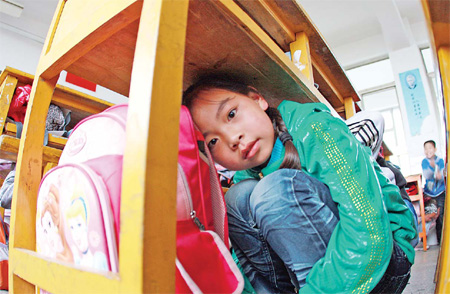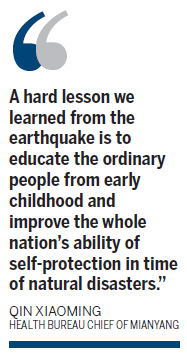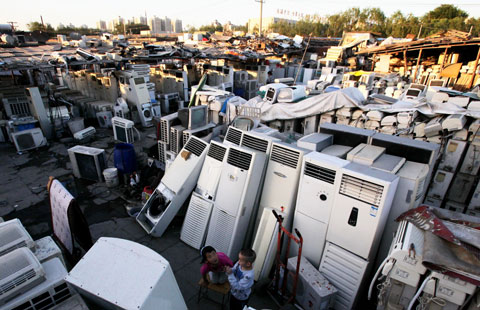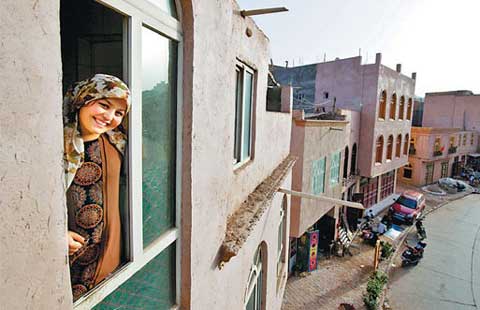Information vital for quake response
By Jiang Xueqing (China Daily) Updated: 2011-05-12 06:50Emergency teams need accurate data, Jiang Xueqing reports in Sichuan.
At 3 am on May 13, 2008, Wang Shengyue, exhausted and out of breath, arrived in Guangyuan with urgent news. An 8.0-magnitude earthquake had struck Sichuan province about 12 hours earlier and Wang had traveled 10 hours nonstop, walking and taking lifts on farmers' motorcycles.
 Children undergo an earthquake drill on Wednesday at their primary school in Lianyungang, Jiangsu province. Schools, hospitals and government institutions have become more diligent about preparing for emergencies since the earthquake in Sichuan province three years ago. Provided to China Daily |
He was a Party committee member in Qingchuan county, 120 km away, and he had been sent to report the disaster.
Zhang Zhirong, director of emergency response in Guangyuan, was with other leaders in the city government compound. Wang told them Qingchuan had suffered heavy losses, with many homes destroyed and people calling for help everywhere.
Zhang asked how many people had died but Wang did not know. "Then we asked Wang how many homes had collapsed, but he couldn't give us any figures. The county had lost touch with towns under its administration."
Providing disaster relief relies on information as much as tents and bottled water. Guangyuan had little of either. Much has changed in three years.
Before Wang arrived that early Tuesday, Zhang had heard from all of Guangyuan's counties and districts except Qingchuan, where telecommunication was lost. The city government had sent more than 400 people to the county in three groups - two on foot from the south and one by boat from the north - to find out what was going on, but they had not been able to call in with information.
Guangyuan recorded only 13 dead on the day of the earthquake. It sent rescue teams to Mianyang, a city within three hours' drive, where the damage was reported to be very serious. Later, as more information streamed in, the death toll for Guangyuan passed 4,850, far beyond the government's expectation.
Not enough money

Top: Firefighters and medical staff from Guangyuan, Sichuan province, run through emergency procedures in this 2010 photo. Provided to China Daily Above: The destruction of the building in Beichuan county, by the 2008 earthquake, illustrates the need for disaster readiness. [Photo/China Daily]
Since he was appointed to his position in 2001, Zhang had dreamed of building an emergency command center. There was never enough money.
His office of 10 employees had a budget of 50,000 yuan ($7,700) a year covering the expenses of everyday work, including phone bills, business travel, water and electricity. The central government would send money to the local government to subsidize quake-affected people's spending on food, clothing and housing, but only if a natural disaster occurred. Guangyuan received 15 million yuan a year at most.
The Sichuan government had a budget of 3 million to 4 million yuan for disaster relief and Guangyuan had 1 million to 3 million yuan, but that was far from enough to build an emergency command system or set up storage for relief supplies, Zhang said.
His dream has since been realized, at the cost of the devastating earthquake.
Computer connections
After the quake, the city bought 15 satellite phones to make sure communication among its major departments can be maintained during a severe natural disaster. County governments made purchases according to their budgets and needs. In Qingchuan, one of the 10 worst-hit counties, each town now has a satellite phone.
Major government officials from the township to city level are equipped with mobile emergency phones. Supported by telecom base stations that are built to withstand major earthquakes, the phones can work when power and phone services are down.
The construction of the emergency command center was completed in December. The center, costing more than 4 million yuan, includes offices and a computerized command system.
All counties and districts of Guangyuan can log on to the system to report and update emergency information to higher-level governments. They can even upload photos and videos taken at stricken areas so the governor will have a clear picture of the situation without being at the site.
The system also has an electronic map that indicates every village in the province. When a disaster hits, Zhang can pull up the map on a big screen and tell his colleagues how many counties are affected, which are worst-hit and which are less seriously damaged.
Three years ago, they had only a paper map. After the earthquake, the city officials moved outside the government building into a courtyard. Zhang took the map from a wall in his office and hung it from branches of a big tree, and the top leaders gathered around to make decisions and give orders.
Now the center is completed, providing decades' worth of improvements. "If we kept moving forward at the same speed as before, it would take us at least 20 more years to build a place like this," Zhang said.
Supplies? Barely
Emergency response in county governments before the earthquake remained at a primary stage of making emergency plans, building rescue teams and storing essentials, said Peng Shiyang, first deputy county chief of Qingchuan. His county had prepared only a small number of disaster relief supplies - including 70 tents, 1,000 quilts and 6,000 clothing items - for 247,953 people.
In Guangyuan, speed boats are often used in rescues during the summer, when many streams are flooded. Beyond those, the disaster supplies on hand at the time of the quake consisted of trucks, ropes, wood and wire. Local rescue teams had nothing but shovels to carry to Qingchuan.
In 2009, the city received 11.48 million yuan from the central government to buy the most-needed rescue equipment, including life detectors, bulldozers and excavators.
The shortage of emergency essentials astounded rescue workers in Sichuan three years ago. Almost all medicines and medical equipment were in short supply. Bed sheets were cut into bandages and white spirits were used as a disinfectant.
Many people with serious injuries asked for painkillers desperately. Some even begged doctors to end their lives, said Zhang Tianlu, chief of the health bureau of Pingwu county.
"The public health system in Pingwu suffered grave losses during the earthquake," he said. The county's death toll reached 3,014. "Today's opportunity of development was gained at the cost of lives."
After the earthquake, Pingwu received nearly 300 million yuan to build 10 county-level health units and 25 township health centers. Each has a first-aid station. The county hired more than 100 medical workers, increasing the population of doctors and nurses by 40 percent. Emergency medical technicians were given professional training, and the police, teachers and public servants underwent basic training for emergencies.
"A hard lesson we learned from the earthquake is to educate the ordinary people from early childhood and improve the whole nation's ability of self-protection in time of natural disasters," said Qin Xiaoming, health bureau chief of Mianyang, Sichuan province.
"Courses on emergency treatment should also be opened at all levels of Party schools and public administration schools, so the commanders of public service will know exactly what to do and which orders to give once a disaster breaks out, without any instruction from their superiors."
The value of training

His suggestion was echoed by Wen Gang, an official of Beichuan county. When the disaster arrived at the doorstep of Beichuan, Wen was in his office on the third floor of the county government building.
With no restroom or other safe area at hand, his first reaction was to run to the door and hide under the doorframe, because it was reinforced by ring beams above. He passed out when the building collapsed and recovered about half an hour later. After he climbed out of the ruins, he found the third floor had become the first floor.
Before the disaster, he had attended a county-sponsored training course on how to hide and escape during an earthquake. "If I had no knowledge of what to do in such a situation, I would not have survived," he said.
Secondary disasters
Beichuan's environment turned vulnerable after the earthquake, and secondary disasters visited the county frequently. In September 2008, huge landslides triggered by heavy rains caught Beichuan by surprise, destroying temporary shelters in the old county town.
The landslides rang a warning bell. Government officials checked all the places where geological disasters were likely to happen and took precautionary measures such as digging ditches and reinforcing riverbanks. They trained a monitor for each major relocation site. If a disaster occurs, the monitor is to report to the government and command the evacuation of residents.
From April to October every year, county officials go to the major sites in jeopardy of secondary disasters to examine how the hazard prevention measures are working.
In 2009, Wen visited Yuanmenba village in Yong'an town, which sits on the middle to lower reaches of several rivers. It was made clear to the villagers that they would hear a gong if heavy rains put the village in danger of mudslides and that they should evacuate immediately. A specific route was designed by the county's land resources department.
Severe floods hit Sichuan and destroyed the road from Dujiangyan city to Wenchuan county last year, but under the new system, Beichuan survived with zero deaths.
Drills, not just plans
As public awareness of disaster prevention has increased, schools, hospitals and government institutions have become more diligent in educating people about disaster response and in conducting drills to reinforce the message.
"There's no doubt of the importance of emergency plans, but when a disaster comes all of a sudden, the plans are either saved in the computers or locked in office drawers," said Wang Dong, director of Mianyang Central Hospital. "It is the drills - not the plans on paper - that we can rely on."
Every semester, the central primary school of Malu town in Qingchuan county holds different drills on how to escape an earthquake, flood or mudslide. In the drill for earthquakes, on hearing a siren, the students leave the classroom in order through the nearest door, get down to the sports ground as quickly as possible via designated stairways, assemble in units of classes and curl up. It usually takes less than 10 minutes for more than 900 students and teachers to leave, said the school principal, Huang Yong.
Remember the risk
The Chinese government and public have attached more importance to disaster prevention and emergency response, but the trauma caused by the earthquake is fading as the disaster-stricken area moves on with reconstruction, warned Zhang, the emergency response expert.
Classrooms in the newly rebuilt Qingchuan Middle School are designed to withstand earthquakes at an intensity level that will do moderate damage to well-built ordinary structures. Students Duan Bingjiao and Li Xiaoqin, both 17, shook their heads when asked whether they had received any training on how to evacuate a building or protect themselves in a disaster.
"We've got to teach our sons and daughters the skills of survival and disaster prevention," Zhang said. "Crustal movements are still active for the moment. It's likely another huge earthquake will strike us at any time. If we forget the pain once the wound is healed, more lives will be put at risk."
- Seven villagers murdered in N China
- China steps up tobacco control efforts
- Five jailed for separatism in Xinjiang
- Letter asks for leniency in poisoning case
- Antibiotics in surface water pose 'indirect health risk'
- Tianjin airport opens up transit link to Beijing
- High levels of antibiotics in China's major rivers
- China to dig tunnel for Asian rail system
- Bering strait line to US possible, experts say
- China: Stop oil rig harassment







